The Mediterranean kitchen represents more than just a design aesthetic; it’s a symphonic blend of cultural richness, warmth, and functionality that transcends ordinary cooking spaces.
Spanish Mediterranean kitchen design embodies an exquisite fusion of rustic charm and contemporary elegance, creating environments that are both visually captivating and supremely practical.
These kitchens are not merely cooking areas but living spaces that celebrate heritage, invite social interaction, and reflect the vivacious spirit of Spanish culinary traditions.
Spanish Mediterranean Kitchen Ideas
With their distinctive color palettes, textural elements, and thoughtful architectural details, Spanish Mediterranean kitchens transform ordinary meal preparation into an immersive, sensory experience that connects homeowners with centuries of gastronomic heritage.
1. Terracotta Tile Flooring: Embracing Authentic Earthen Elegance
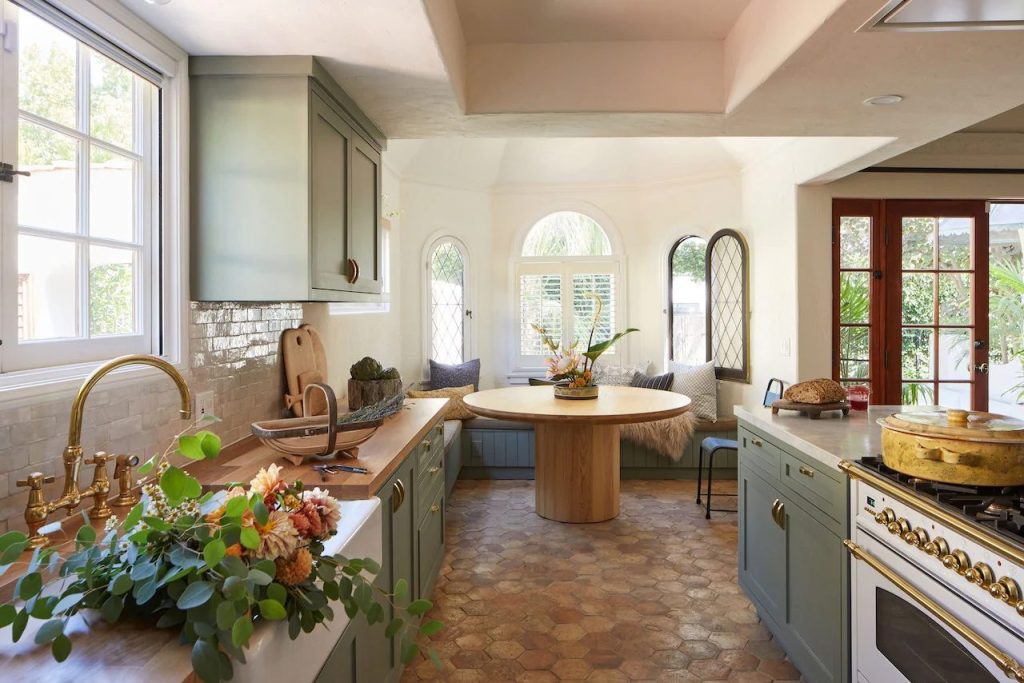
Terracotta tiles are the quintessential foundation of Spanish Mediterranean kitchen design, offering a robust and visually stunning flooring option that immediately transports you to the sun-drenched landscapes of Southern Spain. These handcrafted clay tiles bring an organic, warm undertone to your kitchen, creating a connection with traditional craftsmanship and natural materials.
The rich, earthy hues of terracotta range from deep burnt oranges to softer clay tones, providing a versatile backdrop for various design elements. Each tile tells a story of artisanal creation, with subtle variations in color and texture that add depth and character to your kitchen floor. Beyond aesthetic appeal, terracotta tiles offer exceptional durability and are remarkably easy to maintain, making them a practical choice for high-traffic culinary spaces.
2. Wrought Iron Accents: Intricate Metalwork Magic
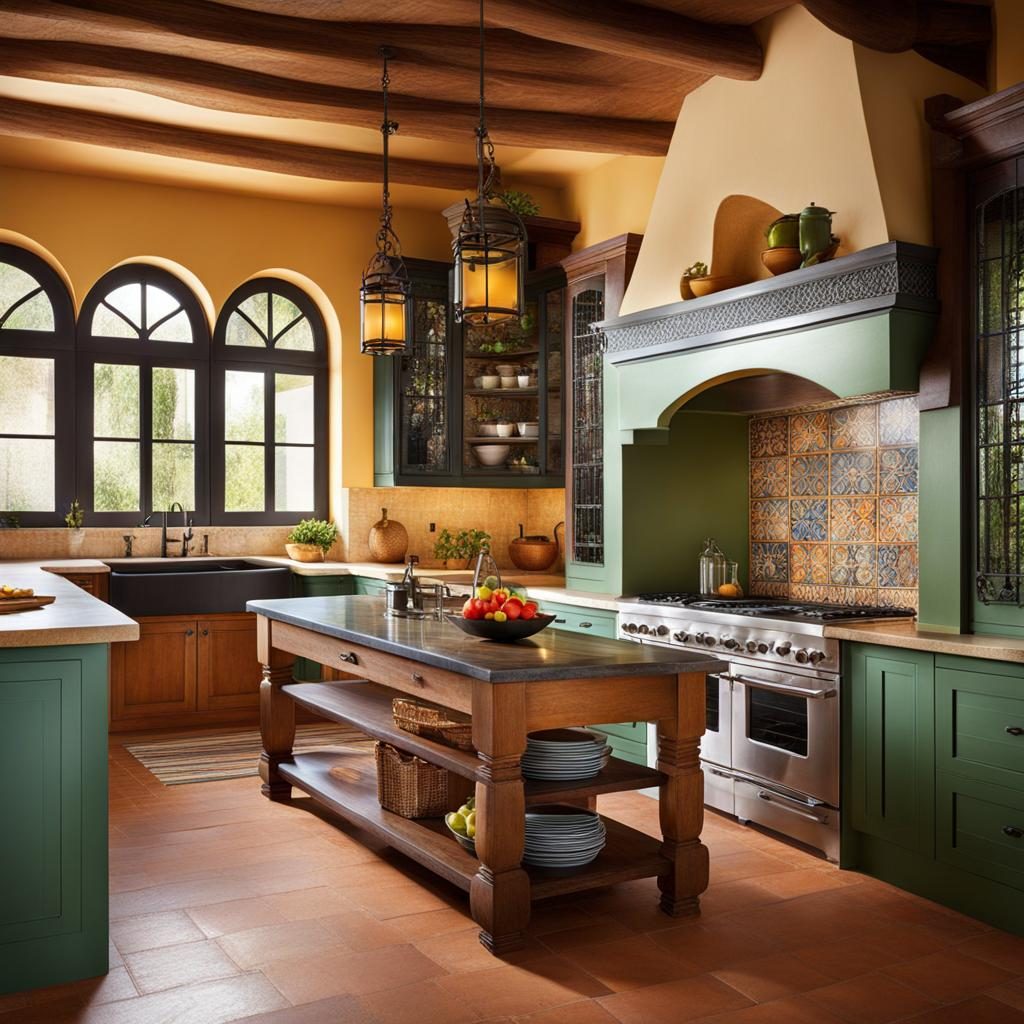
Wrought iron represents the pinnacle of Spanish decorative craftsmanship, introducing an element of sophisticated artistry to Mediterranean kitchen designs. These meticulously crafted metal elements—ranging from delicate light fixtures to substantial pot racks and decorative hardware—infuse spaces with a sense of historical elegance and structural drama.
The dark, rich tones of wrought iron create stunning visual contrast against lighter walls and cabinetry, establishing focal points that draw the eye and spark conversation. Each piece serves not just a decorative purpose but also embodies centuries of Spanish metalworking traditions, connecting contemporary spaces with rich cultural narratives.
3. Vibrant Ceramic Backsplash: Colorful Storytelling Surfaces
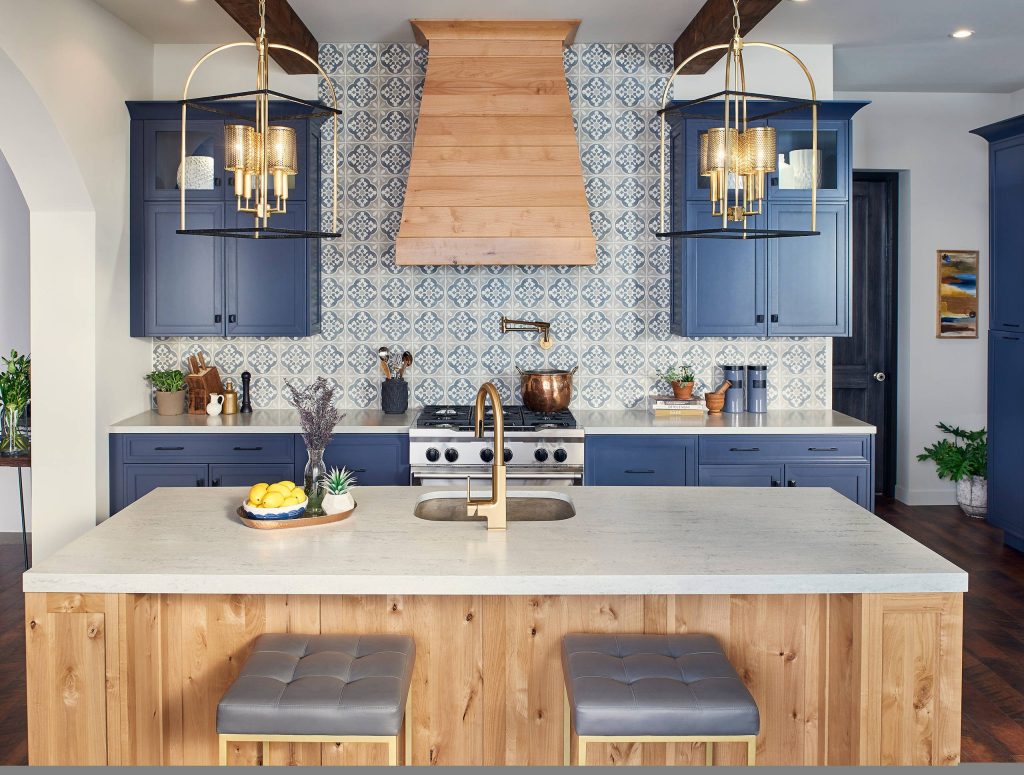
Ceramic backsplashes in Spanish Mediterranean kitchens are far more than functional elements—they are canvases of artistic expression, showcasing intricate patterns and bold color combinations that reflect regional aesthetics. Hand-painted tiles featuring geometric designs, floral motifs, and traditional Spanish patterns transform ordinary kitchen walls into extraordinary visual narratives.
These backsplashes serve multiple purposes: protecting walls from cooking splashes while simultaneously creating stunning focal points that capture the essence of Mediterranean design philosophy. The vibrant blues, terracottas, yellows, and greens typically used in these tiles evoke images of coastal villages, sun-drenched landscapes, and generations of artistic tradition.
Related Guide: 14 Captivating 1950s Kitchen Ideas
4. Open Shelving with Rustic Wood: Natural Warmth and Functionality
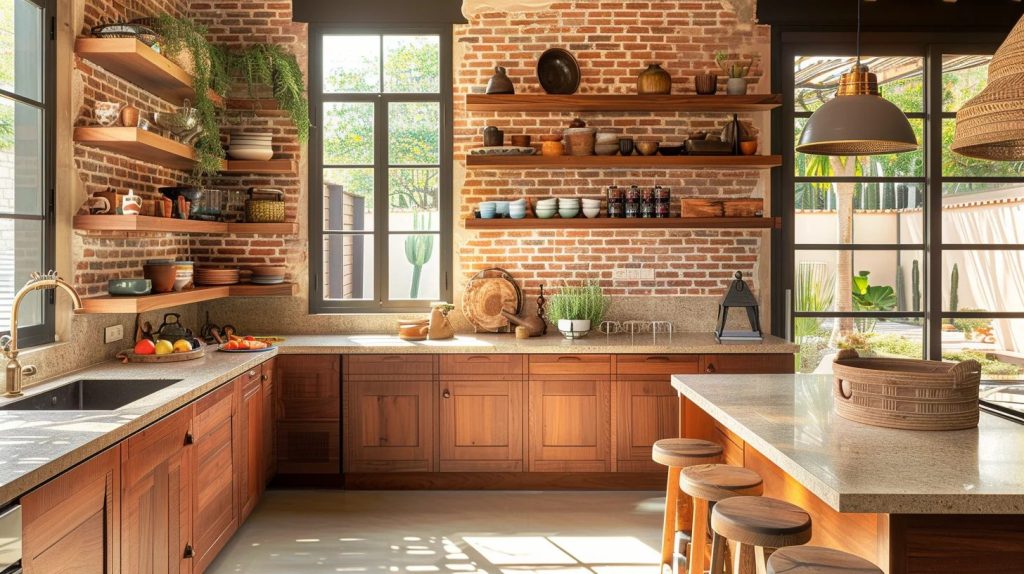
Open shelving constructed from reclaimed or distressed wood epitomizes the Spanish Mediterranean kitchen’s commitment to authenticity and practicality. These shelves provide flexible storage solutions while simultaneously serving as design elements that showcase cookbooks, ceramics, and cherished culinary artifacts.
The natural wood tones introduce warmth and organic texture, creating a counterpoint to sleeker, more modern kitchen elements. Exposed wooden shelves invite a sense of casual elegance, encouraging home cooks to display their most beautiful kitchen items as part of the overall design narrative.
5. Arched Architectural Elements: Timeless Structural Poetry
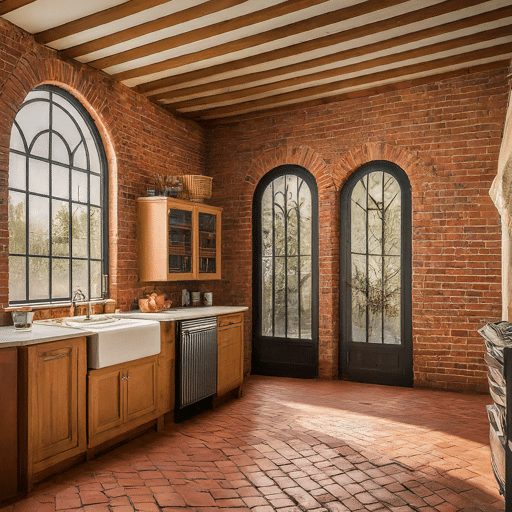
Arched doorways, windows, and architectural details are hallmark features of Spanish Mediterranean design, introducing a sense of historical grandeur and spatial fluidity. These curved architectural elements break away from traditional linear structures, creating visual softness and an almost poetic spatial rhythm.
Arches can be incorporated through doorways leading to pantries, window treatments, or even as decorative niches within the kitchen itself. They represent a connection to historical Spanish and Moorish architectural traditions, transforming kitchens from mere functional spaces into areas of aesthetic contemplation.
6. Mosaic Floor Patterns: Geometric Visual Symphony
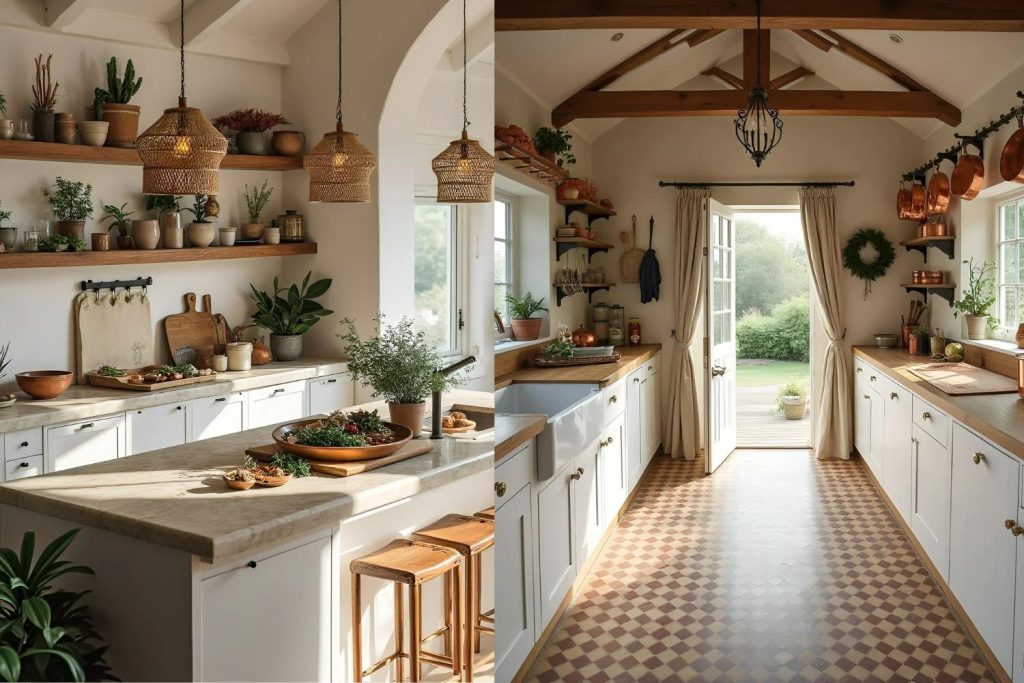
Mosaic floor patterns bring dynamic energy and visual complexity to Spanish Mediterranean kitchens, transforming floors into elaborate artistic statements. These intricate designs, often featuring geometric shapes and carefully arranged tiles, create a sense of movement and depth that elevates the entire kitchen environment.
Traditional Spanish mosaic patterns draw inspiration from centuries of cultural exchange, incorporating influences from Moorish, Roman, and local artisan traditions. Each tile placement is deliberate, creating complex visual narratives that engage and delight the eye.
7. Copper Cookware Display: Functional Artistry

Displaying copper cookware transforms kitchen storage into a design statement, celebrating both culinary functionality and aesthetic beauty. The warm, lustrous tones of copper create stunning visual contrasts and serve as living decor that reflects Spanish kitchen traditions.
Hanging copper pots and pans not only provides convenient access but also introduces a sense of professional culinary authenticity. The metallic sheen catches and reflects light, adding depth and dimension to the kitchen space.
8. Textured Plastered Walls: Architectural Depth and Character
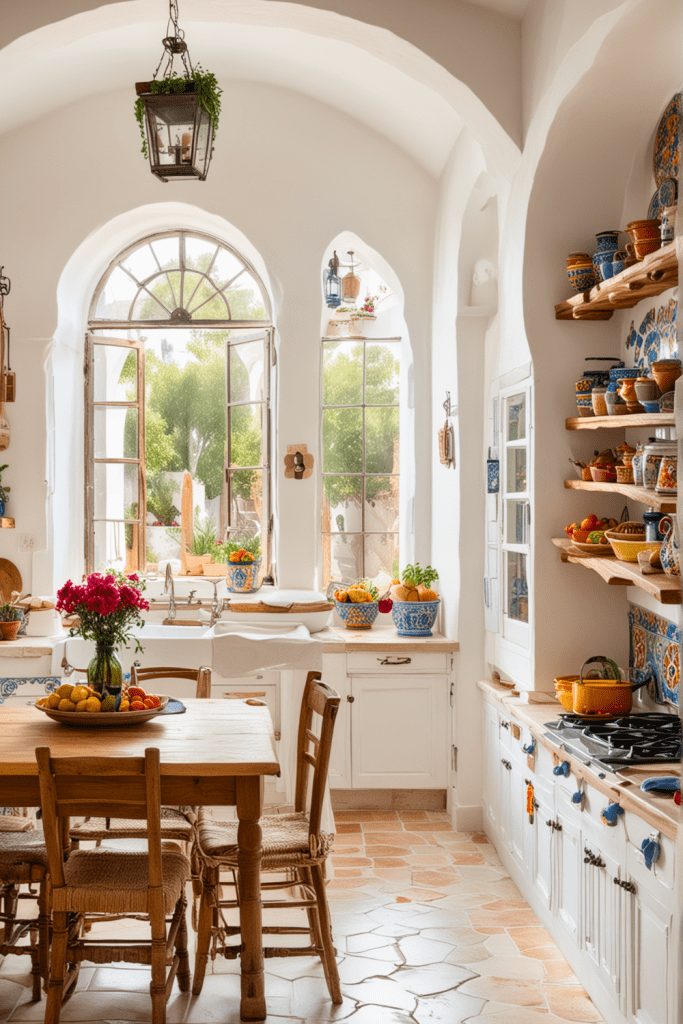
Textured plastered walls capture the essence of traditional Spanish Mediterranean architecture, introducing tactile richness and visual depth to kitchen environments. These walls, often featuring subtle color variations and hand-applied techniques, create a sense of age and authenticity.
The imperfect, organic nature of textured plaster walls tells a story of craftsmanship and tradition, moving beyond sterile, perfect surfaces to celebrate natural variations and human touch.
9. Natural Stone Countertops: Geological Elegance

Natural stone countertops in marble, granite, or local limestone embody the Spanish Mediterranean kitchen’s commitment to organic materials and timeless design. These surfaces offer durability, beauty, and a connection to natural geological processes.
Each stone slab tells a unique story through its patterns and color variations, ensuring that no two kitchen countertops are exactly alike. The cool touch and inherent strength of natural stone provide both aesthetic and functional benefits.
10. Indoor Herb Garden: Living Culinary Ecosystem

Integrating an indoor herb garden transforms the kitchen into a living, breathing culinary ecosystem. Strategically placed herb planters near windows or as dedicated kitchen garden spaces introduce fresh greenery and immediate access to aromatic cooking ingredients.
These living design elements connect cooking spaces with nature, promoting sustainability and providing sensory delight through fragrance, texture, and visual appeal.
Related Guide: 12 Inspiring Greige Kitchen Cabinets Ideas
11. Pendant Lighting with Moorish Influences: Illuminated Artistry

Pendant lights inspired by Moorish design introduce dramatic illumination and cultural depth to Spanish Mediterranean kitchens. Featuring intricate metalwork, colored glass, and complex geometric patterns, these lighting fixtures are sculptural elements that transcend mere functionality.
The play of light and shadow created by these pendants transforms kitchen spaces, creating intimate, atmospheric environments that celebrate historical design traditions.
Conclusion
Spanish Mediterranean kitchen design represents a profound celebration of cultural heritage, artistic expression, and functional living.
By thoughtfully incorporating elements like terracotta tiles, wrought iron accents, vibrant ceramics, and architectural details, homeowners can create spaces that are not just kitchens but living narratives of Spanish culinary tradition.
These design approaches invite warmth, character, and a sense of timeless elegance, transforming ordinary cooking areas into extraordinary environments that nourish both body and soul.

